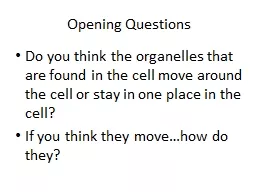

If you think they movehow do they Learning Outcomes Tell what molecules make up the cytoplasm List the important parts of the cell that are found in the cytoplasm Distinguish between cytoskeleton proteins and motor proteins ID: 912097
Download Presentation The PPT/PDF document "Opening Questions Do you think the organ..." is the property of its rightful owner. Permission is granted to download and print the materials on this web site for personal, non-commercial use only, and to display it on your personal computer provided you do not modify the materials and that you retain all copyright notices contained in the materials. By downloading content from our website, you accept the terms of this agreement.
Slide1
Opening Questions
Do you think the organelles that are found in the cell move around the cell or stay in one place in the cell?
If you think they move…how do they?
Slide2Learning Outcomes
Tell what molecules make up the cytoplasm.
List the important parts of the cell that are found in the cytoplasm.
Distinguish between cytoskeleton proteins and motor proteins.
Discuss why the cytoplasm is a major part of
every cell.
Slide3The Three Major Parts of the Cell
Slide4A.
Slide5The cytoplasm is found between the plasma (cell) membrane and the nucleus
It is MADE UP of organic substances and water.
Slide6FOUND IN the cytoplasm :
all the ORGANELLES
AND
CYTOSKELETON
Slide71. Cytoskeleton
The cytoskeleton MADE UP OF protein filaments, motor proteins, and microtubules
Slide8These fibers extend from the nucleus to the cell(plasma) membrane
Gives shape and allows the cell and organelles to move.
Slide9Slide10Cytoskeleton
1. Microtubules
2. Protein Filaments
A. Intermediate
B. Actin
3.
MotorProteins
A.
B.
C.
Slide112
. Tubules of the Cytoskeleton
a. microtubules
b
. intermediate filaments
c. actin
filaments
B and C are PROTEIN FILAMENTS
Slide12Slide13a. Microtubules
Microtubules are small hollow cylinders composed of 13 chains of proteins.
Their assembly is controlled by a structure called a centrosome.
Slide14Slide15The centrosome is a structure that is found very near the nucleus.
Microtubules are said to radiate out from the centrosome.
Slide16This pattern of microtubules helps to maintain a cell’s shape.
It also serves as a track system (like train tracks) in which organelles and materials move throughout the cell.
Slide17A centriole is a structure that comes in pairs and is said to work closely with the centrosome.
The centrioles in the cell play a very important role in cell division (discuss later in the year)
Slide18Slide19b. Intermediate Filaments
They are called intermediate because they are medium in size. (between microtubules and actin filaments)
They are rope like chains of proteins.
Slide20Slide21The intermediate filaments are found mainly between the nuclear envelope (membrane) and the plasma (cell) membrane.
Slide22The proteins that make up these filaments are unique to the cell they are found in.
Example
Intermediate fibers made up of keratin give strength to skin cells.
Slide23c. Actin Filaments
Actin filaments are long filaments.
They are the largest of the three filaments
They are said to be made up of a globular protein.
Slide24Slide25These proteins tend to twist around each other in a helical manner.
The actin filaments form a complex web just under the plasma(cell) membrane.
Slide26The web supports the cell and projections that may come of the membrane.
Slide273. Major Motor Proteins of the Cytoskeleton
a. myosin
b.
kinesin
c. dynein
Slide28Help move organelles around the cell.
Help move materials in and out of cell.
Slide29Myosin works hand and hand with the actin filaments to help with movement in the cell.
They are helpful when the cell engulfs a large molecule.
(pinocytosis or phagocytosis)
Slide30Slide31Myosin hand the actin filaments also are used by the cell to pinch the original cell into two new cells during cell division.
Slide32A process known as cytokinesis.
Slide33Myosin is also used by muscles cells
When muscles contract, myosin pulls actin filaments to the middle of the cell
Slide34Finally
kinesin
and dynein are motor proteins that help move organelles around the cell…
They attach to the organelle..
unattach
and then reattach to the organelle further down a microtubule.
Slide35They also perform the same way when moving material to and from the Golgi Apparatus
Slide36Wrap It Up
Slide37The cytoplasm is ONE of the
THREE
major parts of the EVERY cell.
Slide38Major Functions of Cytoplasm/Cytoskeleton
1. Helps give cell its shape.
2. Moves things for the cell.
3. Holds organelles.
Slide39Slide40The cytoplasm is ONE of the THREE major parts of the cell.
It is made up of organic molecules (motor proteins/microtubules) and water
Found floating and moving around it are organelles
Slide41Protein filaments and Motor Proteins together in the cytoplasm to give the cell shape and move organelles and materials around the cell.
Slide42These are the main reasons that the
cytoplasm is
considered ONE
of the THREE major parts of
every
cell.